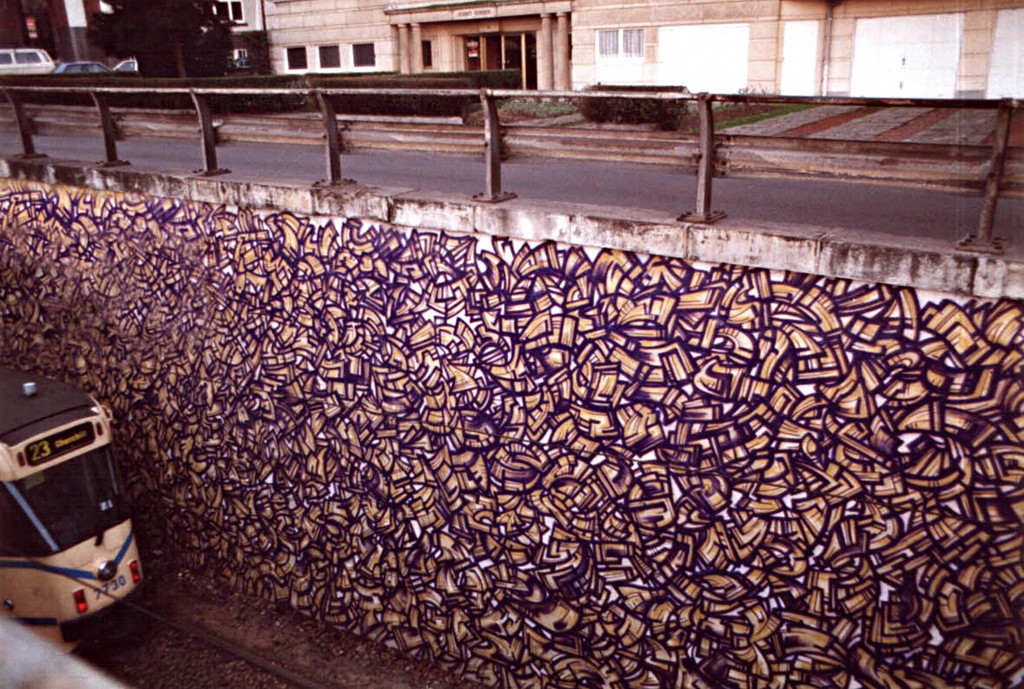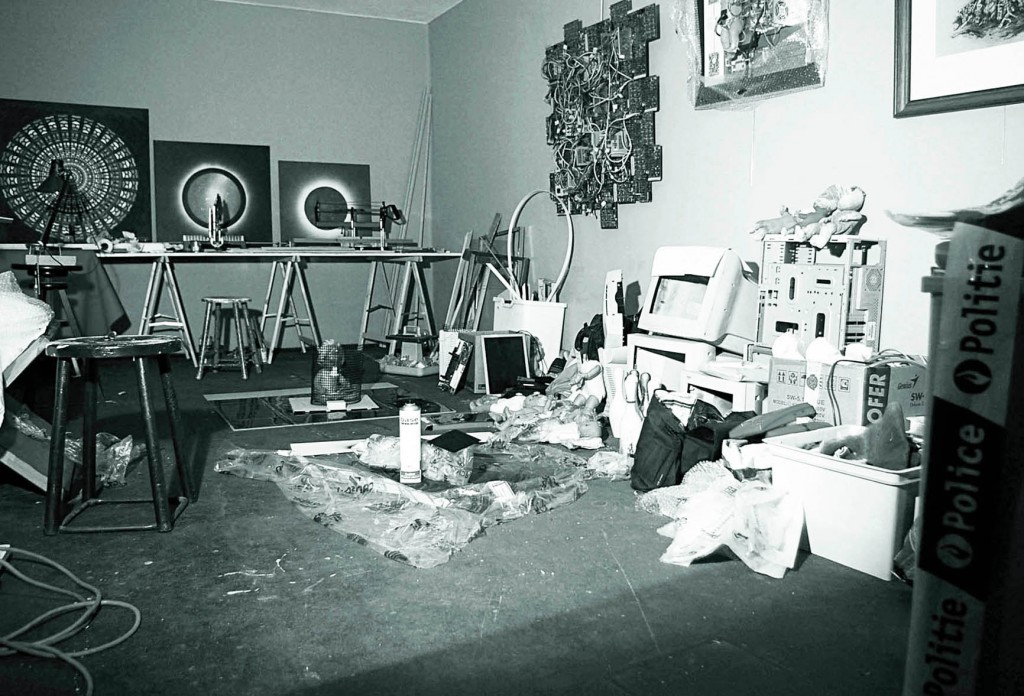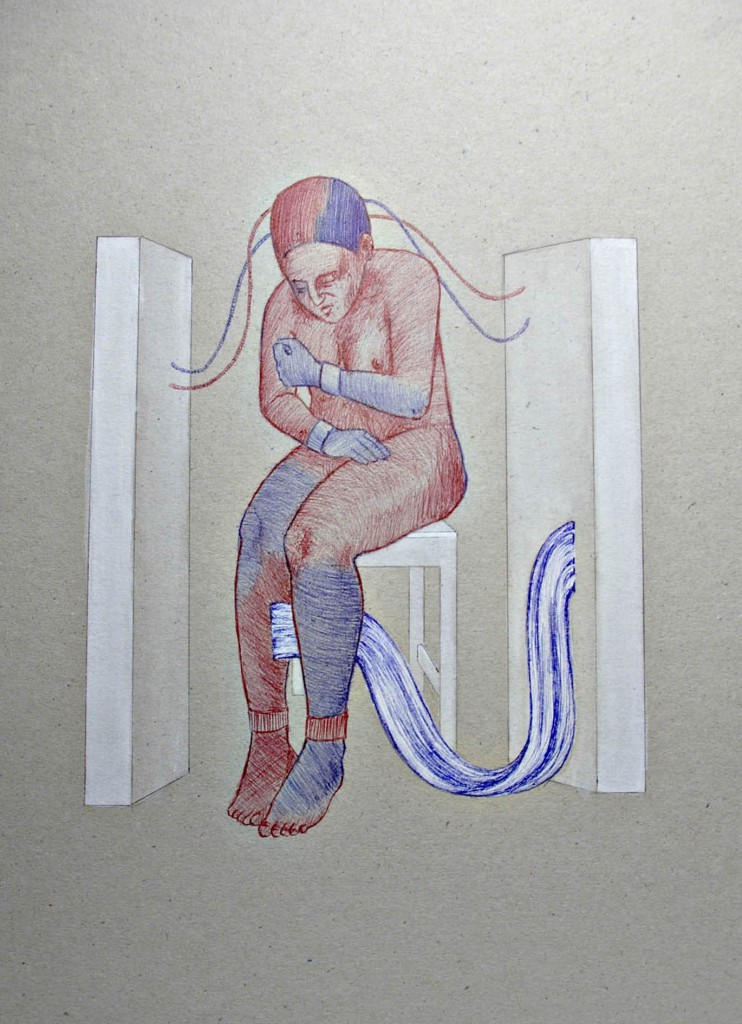|
Take over > Sébastien Laroche-Hôte was born in the world of the drawing because his father, Jacques Hôte (1939-1985), was one of our quite big drawers. His work was, regrettably, dispersed but the big remaining pieces testify of a flawless mastery. To take over was a real wager. To prepare for this difficult succession, Sébastien Laroche-Hôte will follow a complete training course at the Ste Marie Plastic Arts Institute. This institute like no other had inaugurated, under the direction of Pierre-Paul Dupont, a series of exchanges and confrontations under the title of “School in Gallery”. It was a formidable time but a tough school before facing the world of cymas. Sébastien Laroche-Hôte will work long in the shadows before revealing himself finally with works for a long time matured in studio. The feather is light but prying, not a space remains blank of sensations and the glance gets lost in the multiple requests of the image. There are rosettes and wheels, sketched scenes; such details underlined without pressure. We think of some primitive Flemish and their allegories registered in the works as « passing » and which adds only more impact. Indian ink, graphite, lights of amber colors, everything assembles itself to tell a story that the art lover discovers after a real reading because it is never about » general vision » but well a world gently revealed, through of the strokes and shadows, a wonder, sometimes disturbing world, not devoid of humor. Surprised, I discovered an allusion to my tendency for the documentation and the preservation of fainted details that make the joy of art historians. Without shouts and without slivers, Sébastien Laroche-Hôte had seized in our conversation, the small trot of the wheel which turns ceaselessly and forms the major component of the clock of time. An impressive exhibition in his young career and which conceals the hope of a further development which will be rich in emotions and graphic discoveries. © Anita Nardon > A.I.C.A. > B. News > Translation: D.U. ————————– Old school > What we usually call graffiti recovers in fact a vast field of practices, a multitude of styles, registered in various traditions as graphic also as pictorial. We can get easily lost in the semantic intricacies of the term, especially because it is often used in a wrong way. Here, the term graffiti sends back to a very precise tool – the spray-can – and to a specific set of graphic forms. The tag is a part of it, which is a more or less stylized signature made in a line; the bombing (or the chromium) and the throw-up (or the flop) which are big sized letterings painted in two colors; and of course, the fresco of which the level of abstraction is sometimes very high (the Wild style). There are, in this context, no stencils. Appeared in the United States at the end of the 70s, this type of graffiti spread at first in Europe before developing on the scale of the planet, especially in urban areas. So, Paris, Berlin, Amsterdam, London, experienced their first graffiti at the beginning of the 80s, at a time when the New York graffiti was making its entrance to specialized art galleries. The graffiti’s history was marked by the evolution of styles, materials (trains, subways, walls, wooden panels, canvases) and the evolution of places (streets, disused spaces, art galleries), in relation with many designations : writing, graff, graffiti-art, subway art, spray-can art, tag (sometimes synonymous with graffiti, in French) and more recently, street art or urban art. In Belgium, this type of graffiti dates of the end of 1980s. Non-initiated, the general public reserved it a rather lukewarm reception. Public authorities, for their part, deployed with time efforts to encircle it; the taken measures being alternately repressive and socio-educational. The development of the Belgian graffiti was strongly linked to the formation of precursors groups as dta, dsc, brc, rab or cnn.
Psychedelic way / Outside mural painting > acrylic > General Meiser place > order for S.T.I.B. > Surface 232,500 in² / 150 m²
Psychedelic way – detail Among the pioneers of the Belgian graffiti, we find Sébastien Laroche-Hôte alias Kumi. In his “graffer” past, he certainly joined this tradition, but felt more close to graffers as Lokiss (Paris). Kumi signed numerous frescoes in Belgium: Brussels, Antwerpen, Mons, Liège, Charleroi, as well as in Holland, in Italy and in Greece. He also painted a fresco for the Swatch watches travelling Museum and animated graffiti’s workshops in his artistic studies. Kumi exceeded rather fast the formal register of the graffiti to go towards a more pictorial approach. In this spirit, he had at first a particular interest for the work of the American painter Roy Lichtenstein, emblematic name of Pop Art. This interest has resulted in a series of characters drawn with pencil and felt, of which a part was diffused in Europe, in the form of stickers. Afterwards, Kumi was even farther, tilting to the abstraction, when he left aside the work of letters to exploit the tangle of shapes. The history of graffiti sends inevitably back to a multiplicity of profiles, motivations, courses and visions. What is transverse is credibly the creation will: the work of letters, colors, compositions; the control of the tool and the support, while thwarting the monitoring devices and the attempts of encircling. In other words, the will to surprise, to shake, to resist, to overtake and surpassing one ‘self by the way and in the continuation of a creative act, carried by the challenge and the adrenaline. © Marisa Liebaut / ————————– Microcosm > Son of the drawer and sculptor Jacques Hôte, Sébastien Laroche-Hôte prolongs in his way a work unanimously greeted by the critics. Without disavowing the lessons of past, he fits nevertheless in the variety of our time. After having tried the abstraction and the wall fresco, his career curiously led him to the drawing in a style which we would qualify gladly as classic. Intimate or imaginary representations in the charcoal but especially abundant compositions in the Indian ink, in the graphite, heightened by colors, which present condensed humanity on the background of allegories and universal symbols, among which the wheel or the rosette look like red thread. A microcosm which one grasps as we unravel the skein of an enigma, whose content sends back to the big existential questions. Besides the jubilation that procures the reading of these multiple stories, the drawings of Sébastien Laroche-Hôte also evoke a procession of emotions which are embodied in characters alternately roguish, meditative or amazed to be there.
The next exhibition at the gallery will be the opportunity to do more ample knowledge with the richness of this universe. As for the Espace Blanche Art Gallery, it will propose to discover another aspect of his work, through series of three-dimensional compositions which denounce, in a vision of anguish, the dangers of an almighty technology put at the service of the control of individuals. © Didier Paternoster > L’événement > Translation: D.U. ————————– H program > Before being an artist, Sébastien Laroche-Hôte is, above all, a patient observer of illusive appearances of the contemporary society. The coexistence of its peculiarities, psychological, sociological, religious or spiritual is the basic material of his work. The human being, central element, and his quest for sense, situating the junction point on the interface of the big “Labyrinth”. The addiction, the irrepressible need to belong to a definite group, to a school of thoughts and action, appears to him as scattered elements hindering a global vision of the phenomenal world and its relative reality, transitional and impermanent. Therefore, the medium or format used to extract out of it the conceptual illusion are secondary ; only counts the universal symbol emanating from the graphic representations, bi- or three-dimensional ; micro and macro being indefinitely mouldable ; the only optic collision, a subjective awakening of the collective psychic, having a reason to be.
Downloaded, remote guided, settled in simultaneous networks and often without their knowing in a pyramidal world, beaconed by a mega-program pre-configured and undetectable : “The Beast”. The anomaly’ subordination to the Order. The toxicity of digital enslavement that hunts the visual intuition through graphic images, is revealed, bare and exposed to the incredulity of observation. The consumption society’s consensual support for a paradigm formatted freedom, the screening of the information and disinformation flow, the interactivity between intelligence and artificial intelligence, the hybridising of a coded neo language ; as many access lines for a conscience calling out and an individual exploration of what he calls “H Program” or – humanoid intranet program -. © Bella Davis > F-Main / ————————– Progress under my skin > We live in a wonderful time. On This side of the world in any case. Our life expectancy beats all records, our access to the world reduced to almost nothing the borders of time and space, each day brings its discoveries, always pushing away farther these threats that used to make our grandparents tremble. In a few decades only, science, technology, information… have disrupted our every life and are today an integral part of our existence. In the name of health, comfort, safety,… In the name of the greater welfare in general. Neverthless, happiness does not seem to be at the end of the road. This prefabricated lifestyle generates uneasiness. This uneasiness inducessometimes alarming questions about our future. The current work of Sébastien Laroche-Hôte is situated in the heart of this questioning. Stemming from a « classic » tradition, he first investigated the meanders of the line, the mysteries of the geometry as well as a beautiful sample of the human race in a determinedly figurative vein. Humanity is for him much more than a source of inspiration or a subject of study. It is about a voracious concern that mobilizes at the same time his senses, his neurons and his empathy, without forgetting this precious enthusiasm, which handles humor in the seriousness.
The current comment of Sébastien Laroche-Hôte, even if it is not necessary to reveal or to denounce, delivers neverthless a reality that exceeds blithely the fiction framework, and even some science fiction. Is humor the safeguard of the craziest interpretations or a necessary balm for such confrontations? The question arises. Carcasses of computers, processors, memory cards, blind screens, batteries, medical radios, syringes, baxters,… The scenery is planted, the machinery in place to welcome those substitutes of humanity that are « test babies », impersonal dolls that integrate marvelously into this heterogeneous assembly. Immobilized, cabled, connected, they could be as well an emanation of the machine in our image, the ultimate stage of life’s instrumentalisation. At this stage, beyond the reflection about an area, the artist’s vision expresses very real anguishes. Up to the viewer to continue the dialogue with the work but also with himself. The work of Sébastien Laroche-Hôte is far away from any heated debate. If he wants to arouse reflection, it is without the will to shock. His approach is based on an objective observation that questions drifts, proven or possible, technological developments: galloping traceability, multiplication of identification’s process, conditioning, violation of privacy and ethics, human experimentation… So many debates that shake the public opinion, without real incidence on the process. In a language of a necessary austerity, handling a material of which he scrutinizes the impact on our existence, Sébastien Laroche-Hôte confirms this orientation of a work that remains, despite all, profoundly human. © Didier Paternoster > brusselsmuseum.be |





